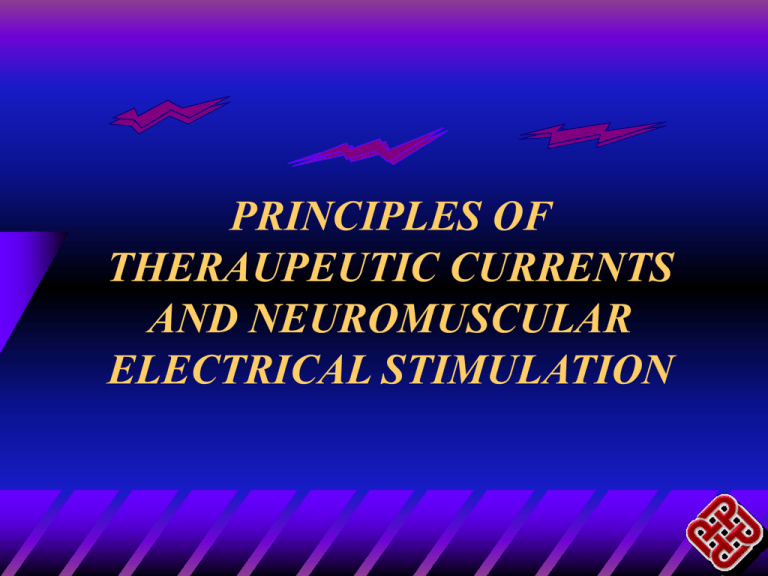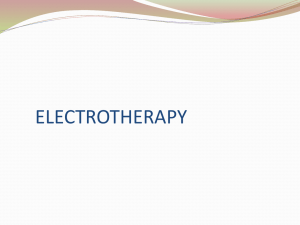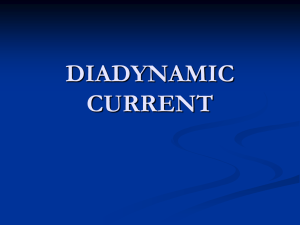NEUROMUSCULAR ELECTRICAL STIMULATION
advertisement

PRINCIPLES OF THERAUPEUTIC CURRENTS AND NEUROMUSCULAR ELECTRICAL STIMULATION OBJECTIVES Describe the electrophysical principles related to therapeutic currents; Given a therapeutic current, describe the characteristics of the current; List and ratify the factors that affect current conductivity; Identify the essential features of each NMES, apply in a safe and correct manner OBJECTIVES Describe the physiological effect of electrical stimulation; Given a clinical condition, justify the choice of stimulation parameter and protocol based on the physiological and clinical effects CONTENTS Basic concepts of electrophysics and therapeutic currents; Description and characteristics of therapeutic currents; Basic features of the commonly used NMES Review of basic physiology of muscle and nerve; Application principles and selection criteria; Clinical indication and precaution THERAPEUTIC CURRENTS Therapeutic currents can broadly be defined as electrical currents, produced by electrotherapeutic devices, induced to the body tissues to elicit certain physiological /clinical effects. Neuromuscular electrical stimulation (NMES) is the application of electrical current to elicit a muscle contraction CLASSIFICATION OF THERAPEUTIC CURRENTS A continuous unidirectional flow of charged particles (current) Direct Current Uninterrupted bi-direction flow of current Alternating Current cps or Hz Unidirectional or bi-directional flow of current that periodically ceases for a finite period of time Pulsed Current pps DESCRIPTIVE CHARACTERISTICS PHASES Monophasic Biphasic Triphasic Polyphasic SYMMETRY OF PHASES Symmetric Asymmetric BALANCE OF PHASE CHARGE Balanced Unbalanced QUANTITATIVE DESCRIPTIONS OF PULSED AND AC Amplitude-Dependent – – – – Characteristics Peak amplitude Peak-peak amplitude rms amplitude Average amplitude Time Dependent Characteristics – – – – Phase and pulse duration Rise and decay time Interpulse and intrapulse period and frequency QUANTITATIVE DESCRIPTIONS OF PULSED AND AC Amplitude and time-dependent characteristics – Phase charge – Pulse charge – µC CURRENT MODULATION – Amplitude modulation – pulse duration modulation – frequency modulation Timing Modulations – burst mode – duty cycle 5s 20s Duty cycle 20% TERMINOLOGY OF THERAPEUTIC CURRENTS Shape DC Shape Monophasic Therapeutic currents Pulsed Current Shape Sym Biphasic Balanced Shape Unbal Shape Asym AC Shape Sym Asym Balanced Shape Unbal Shape TYPES OF THERAPEUTIC CURRENTS STIMULATORS http://www.rs.polyu.edu.hk/rssyeung/ept2machine.html TYPES OF THERAPEUTIC CURRENTS STIMULATORS Galvanic stimulators Produce continuous direct current e.g PTU, Ten Pulses Stimulators NEUROMUSCULAR ELECTRICAL STIMULATOR Produces the effect of muscle nerve stimulation “Faradic” type stimulators “Russian” stimulators High Voltage stimulators FARADIC TYPE STIMULATORS Faradic current an asymmetrical biphasic current with a pulse duration of 1 ms 1ms RUSSIAN CURRENT A 2500 Hz AC modulated every 10ms to provide 50 bursts per sec. 10ms interburst 10 ms Burst HIGH VOLTAGE STIMULATORS A twin-spike Waveform: monophasic pulsed current pusle duration: 5-65s Freq: 1-120 pps Peak amp: 500 V (2000-2500 mA) 5-65 µs FUNCTIONAL ELECTRICAL STIMULATOR (FES) INTERFERENCE CURRENT Two AC with slightly different frequency from two independent low voltage AC superimposes (interferes) on the same time axis; The result is a unique pattern of amplitude modulation “beat” with a beat frequency of 1-100 bps. ELECTRODES A conductive materials that serves as the interface between a stimulator and the patient’s tissues TYPES OF SURFACE ELECTRODES Metal electrode durable reusable inexpensive inflexible Carbonised Rubber relatively inexpensive fairly durable gel or water required may cause skin irritation SPECIALISED PROBE Allow point stimulation location of motor point EFFECTIVE ELECTRODES With low skin-impedance Uniform in current conductivity avoid skin irritation with uniform contact on treatment surface cost effective SIZE OF ELECTRODES Current density inversely proportional to the electrode contact area ELECTRODE PLACEMENT Motor point: a point on the skin overlying a concentration of terminal motor nerve branches METHOD OF APPLICATION Polarity - relative charge (positive or negative) of the terminals (electrodes) of an electrical circuit at any one moment of time Cathode-gains electrons and becomes negatively charged Anode-loss electrons and becomes positively charged Active electrode-cathode MONOPOLAR TECHNIQUE The active electrode (cathode) to the muscle motor point An indifferent electrode to complete the circuit BIPOLAR TECHNIQUE Both electrodes on the muscle usually muscle for large BIFURCATED TECHNIQUE Common in HVG machine electrode from same polarity bifurcated into two muscle with multiple motor points composite muscle action with different muscles ACTIVATION OF EXCITABLE CELLS WITH THERAPEUTIC CURRENTS EXCITABILITY OF NERVE CELLS Resting potential – -70 mv Intracellular or extracellular stimulation, offset the resting potential when membrane potential reaches threshold, AP generated Na+ ++++++++++++ K+ ------------------ -90 -80 -70 -60 -50 -40 -30 -20 -10 0 +10 +20 +30 +40 mv Action potential of muscle Action potential of nerve Threshold of muscle and nerve APPLICATION PRINCIPLES In electrical stimulation, current induced must be of sufficient amplitude and duration to bring excitable cells to the threshold of deplorization SD curve STRENGTH DURATION CURVE Pulse amplitude mA Sub threshold Suprathreshold 2x mA Rheobase x mA Chronaxie Duration ms A C fiber Motor fiber Mixed peripheral nerve inherent excitability of the nerve fibre Site and location Prickling sensation Sensory Nociception Peripheral nerve Skeletal mm Motor Therapeutic current Visceral mm Denervated Muscle fibre Muscle contraction S-D CURVE OF DIFFERENT NERVE FIBRES C Sizes dependent! Selective activation Pulse amplitude mA Duration ms FACTORS THAT AFFECT CURRENT CONDUCTIVITY Electrode-skin interface Ohm’s law V=IR Resistance=the ease or difficulty of a DC passes through a material. – the number of free electrons – viscosity of the material – temperature Impedance= the ease or difficulty of AC passes through a material. HUMAN SKIN Poor conductor Dry skin = 1 M ohm Wet skin = 1 K ohm The conductivity of human tissue depends on the proportion of water content – – – – skin 5% bone 5% fat 15% muscle 75% Clean Wet Warm Site MUSCLE FORCE GENERATION Types Type of muscle fibres I – twitch duration 120 ms 0 Type II – twitch duration 30-50 ms 30 60 90 120 ms FACTORS DETERMINE MUSCLE FORCE GENERATION Spatial and order of recruitment – (size principles) Temporal summation – Frequency Asynchronisation vs Synchronisation Twitch of contraction 0 1000 ms Fused contraction STIMULATION PARAMETERS Current density (spatial recruitment) Pulse/phase duration (SD curve) Frequency (temporal summation effect, twitch duration of Type I and II fibres) Waveform (comfort level and effective current density) on/off cycle (physiological movement, fatigue) APPLICATION Selection of electrodes Method of application Placement and inter-electrode distance TREATMENT DURATION AND FREQUENCY Duration: number of contractions / total time of treatment Frequency: session of treatments per day or week Stimulation parameters Application Duration CLINICAL APPLICATION Muscle strengthening in healthy subjects Treatment of disuse atrophy Muscle re-education and facilitation Increase range of motion Functional Electrical Stimulation (FES) MUSCLE STRENGTHENING IN HEALTHY SUBJECTS Yakov Kots (Russian technique) Current Amplitude On/off cycle Session Result 2500 Hz, modulated to 50 bursts 110-130% of MVIC 10 s / 10s 3/52 3-40% in strength, 3-4/52 CLINICAL CONSIDERATION Phase duration Waveform Current Amplitude on/off 20-1000 s rectangular or subject preference burst modulated AC maximum tolerable 10-15s / 50-120 s CLINICAL CONSIDERATION Method of application – depends on muscle size, group Contraction Duration Frequency isometric/concentric 10x3 3/52 DISUSE ATROPHY Is there a selective loss of muscle fibre in disuse atrophy? How would that affect your treatment plan? A SUGGESTED PROTOCOL Severe Moderate Minimal Freq 3-10 10-30 30-50 On 5 5-10 10-15 Off 25-50 20-30 10-30 Duration 5-10 15 15 INCREASE ROM Causes Single channel Dual channel MUSCLE RE-EDUCATION AND FACILITATION Re-establish voluntary control of body positions and movement following injuries that affected either both the afferent, efferent neural pathway or the central control centres in the motor and premotor cortex FES SAFE AND PROPER APPLICATION Selection of proper stimulators Output amplitude programming Portable No of vs channels Stimulationline-powered Parameters Fine adjustment Safety features SAFE AND PROPER APPLICATION Documentation Current intensity Electrode placement Proper Decrease skin skin sensation impedance test Stimulation parameters CONTRAINDICATIONS Patient with cardiac pacemaker Area of pregnant uterus Treatment of open wounds or skin lesions Acute inflammatory conditions Inability to communicate Benign / malignant tumours, T.B., osteomyelitis OBJECTIVES Describe the electrophysical principles related to therapeutic currents; Given a therapeutic current, describe the characteristics of the current; List and ratify the factors that affect current conductivity; Identify the essential features of each NMES, apply in a safe and correct manner OBJECTIVES Describe the physiological effect of electrical stimulation; Given a clinical condition, justify the choice of stimulation parameter and protocol based on the physiological and clinical effects








